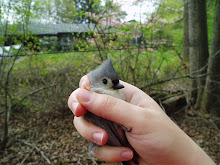Then a large, mostly transparent creature comes into focus. It doesn't look like all the others. It's far more complex, like a mechanical sea creature in miniature. Something like this:

Beautiful, isn't it?
This is a rotifer, a tiny aquatic animal in the phylum Rotifera. It may be small, but it is bilaterally symmetric and has a distinct head. It pulls in food particles with the wheel-like structure (hence "rotifer" or "wheel-bearer") around its mouth.
The rotifer pictured above is, however, special for another reason. This is a bdelloid rotifer (the b is silent). You are looking at a species that has not mated in at least 40 million years.
All bdelloid rotifers are female, and they reproduce by parthenogenesis. (Olivia Judson talks about them at length in her excellent book, Dr. Tatiana's Sex Advice to All Creation, and wrote a column about them in June.) This is highly unusual, since it is generally thought that gene exchange is an important mechanism for evolution. Yet with no sexual reproduction, how could the bdelloids have speciated so intensely (there are estimated to be 350 species) and persisted for so long?
Researchers at Harvard and Woods Hole may have the answer. In a paper published in Nature in May, geneticists found that when they analyzed rotifer DNA, they found genes known to occur in plants, fungi, and bacteria. This evidence suggests that rotifers have been engaging in horizontal gene transfer (HGT).
HGT is a well-known phenomenon, but it was primarily known from single-celled organisms. For example, many bacteria are known to incorporate novel genes from other members of the population, or even from other species. When you only have one cell, it's not too hard to get a novel gene into that cell. Most animals, which are by definition multicellular, can't do this; most of us pass our genes to our offspring via specialized reproductive cells, which are typically hidden away inside gonads. Unless novel genes make it to the sex cells and can therefore be passed on to the next generation, HGT has not taken place. (Passing genes to your offspring is vertical inheritance.)
Bdelloids, however, appear to be capable of massive horizontal gene transfer. Gladyshev et al. point out that this is not a case of rotifers simply retaining genes that are common to all life; that case is both extremely unlikely and not supported by the data. Instead, they suggest,
It may be that HGT is facilitated by membrane disruption and DNA fragmentation and repair associated with the repeated desiccation and recovery experienced in typical bdelloid habitats, allowing DNA in ingested or other environmental material to enter bdelloid genomes.
With their proclivity for moist habitats, bdelloids also run the risk of dessication. They are able to withstand repeated dessication; in fact, it might be necessary for the continued success of the entire class, since this appears to be the mechanism by which they gain new genetic material. The authors conclude,
Although the adaptive importance of such massive HGT remains to be elucidated, it is evident that such events have frequently occurred in the genomes of bdelloid rotifers, probably mediated by their unusual lifestyle.
So, in conclusion, bdelloids have done away with sex as we know it, but periodically get turned into rotifer jerky, incorporate new genes while their cells are cracked open, and when reconstituted and repaired produce more copies of themselves, thus passing new genes to the next generation.
Lots of questions remain; for example, what are rotifers doing with all these new genes? (One example is a bacterial gene for cell walls; no one knows how an animal might make use of a cell wall.) I will keep you posted on all rotifer-related news updates. Stay tuned!
References
Gladyshev, E. et al. "Massive Horizontal Gene Transfer in Bdelloid Rotifers." Science 30 May 2008: Vol. 320. no. 5880, pp. 1210 - 1213
Judson, O. "The Weird Sisters" The New York Times, June 3, 2008.



No comments:
Post a Comment